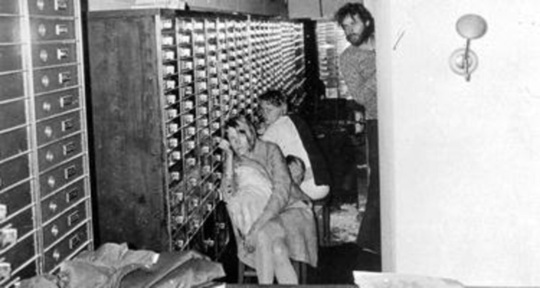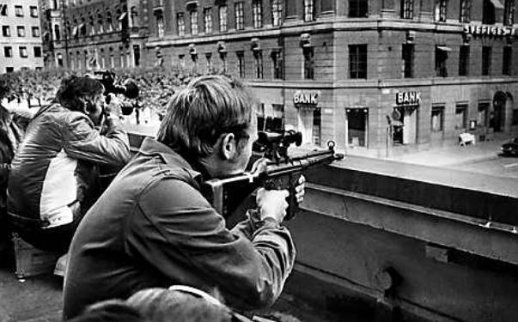'Stockholm Syndrome' turns 40
It's 40 years ago today since 'Norrmalmstorgsdramat,' the bank robbery in Stockholm City that coined the phrase.
-
 August 23, 2013 marks 40 years since the infamous Norrmalmstorg robbery began, leading to six days when the eyes of the world were on Stockholm, Sweden. Above the widely circulated photo taken through the hole in the wall and showing hostage Birgitta Lundblad seated in front, Elisabeth Oldgren behind her, and between then Sven Säfström (all of whom worked at the Kreditbanken). Standing is Clark Olofsson, who was convicted of helping main robber Janne Olsson.
August 23, 2013 marks 40 years since the infamous Norrmalmstorg robbery began, leading to six days when the eyes of the world were on Stockholm, Sweden. Above the widely circulated photo taken through the hole in the wall and showing hostage Birgitta Lundblad seated in front, Elisabeth Oldgren behind her, and between then Sven Säfström (all of whom worked at the Kreditbanken). Standing is Clark Olofsson, who was convicted of helping main robber Janne Olsson. -
-
'Stockholm Syndrome' turns 40
it is 40 years since the Norrmalmstorg robbery ('Norrmalmstorgsdramat'), the famous hostage crisis that is the basis for the term ”Stockholm syndrome”. It occured at the Norrmalmstorg square in Stockholm in 1973, and was the first criminal event in Sweden to be covered by live TV.
Jan-Erik ”Janne” Olsson, on leave from prison, went into Kreditbanken (today a part of the Nordea bank) at Norrmalmstorg in central Stockholm, and attempted to hold up the bank. Swedish police were immediately called, two of them went inside, Olsson opened fire and injured one of them. The other was ordered to sit in a chair and ”sing something.” Olsson then took four people as hostages, and demanded that his friend Clark Olofsson (a repeat offender, and a more experienced criminal than Olsson) be brought to the bank along with 3 million SEK ($730,000 in 1973), two guns, bulletproof vests, helmets and a fast car.
By permission by the government, Olofsson was brought in. One of the hostages, Kristin Enmark, said she felt safe with Olsson and Olofsson but feared police might escalate the situation by using violent methods. Olsson and Olofsson then barricaded the inner main vault in which they kept the hostages, negotiators agreed that they could have a car to escape but would not allow them to take any hostages with them, if they tried to leave. -
 August 28, 1973: police officers wearing gas masks escorting Olsson in handcuffs after the hostage drama at the Kreditbanken bank on Norrmalmstorg. Nordstjernan archives.
August 28, 1973: police officers wearing gas masks escorting Olsson in handcuffs after the hostage drama at the Kreditbanken bank on Norrmalmstorg. Nordstjernan archives. -
-
A 'displeased' hostage
Meanwhile, Olsson called up Prime Minister Olof Palme and said he would kill the hostages. The day after, hostage Kristin Enmark called Palme saying she was displeased with his attitude and that he should let the robbers and the hostages leave. On August 26, police drilled a hole into the main vault from the apartment above, and from this hole a widely circulated photo of the hostages with Olofsson was taken. Olofsson also fired his weapon into this hole on two occasions, wounding a police officer in the hand and face. Olsson fired his weapon and threatened to kill the hostages if any gas attack was attempted. On August 28, the gas was used nevertheless, and after half an hour Olsson and Olofsson surrendered. None of the hostages sustained permanent injuries. Both Olsson and Olofsson were charged, convicted, and sentenced to extended prison terms for the robbery; Olofsson, however, claimed that he did not help Olsson and was only trying to save the hostages by keeping the situation calm. At the court of appeal, Olofsson's convictions were quashed. He later met hostage Kristin Enmark several times, their families becoming friends. He continued committing crimes, and has spent the majority of his life behind bars, he is currently imprisoned in Denmark. Unlike Olofsson, Olsson, after having been sentenced to 10 years of prison, has been a free man. Today he lives with his fourth wife in Thailand. -
 Sharpshooters on the surrounding buildings follow the events, as do a majority of the Swedish people.
Sharpshooters on the surrounding buildings follow the events, as do a majority of the Swedish people. -
Engagements are a myth
The most widely publicized myth about the robbery, or rather about the Stockholm syndrome, was that one or both robbers became engaged to their captives. This is not true, and may stem from a false friend in the phrase ”att engagera sig i någon”. In Swedish this means "taking interest in someone". It does not mean "to become engaged to someone" (which would be ”att förlova sig med någon”). The Stockholm syndrome means a hostage or hostages express sympathy and empathy and have positive feelings towards their captors, sometimes to the point of defending them. -
-
-
